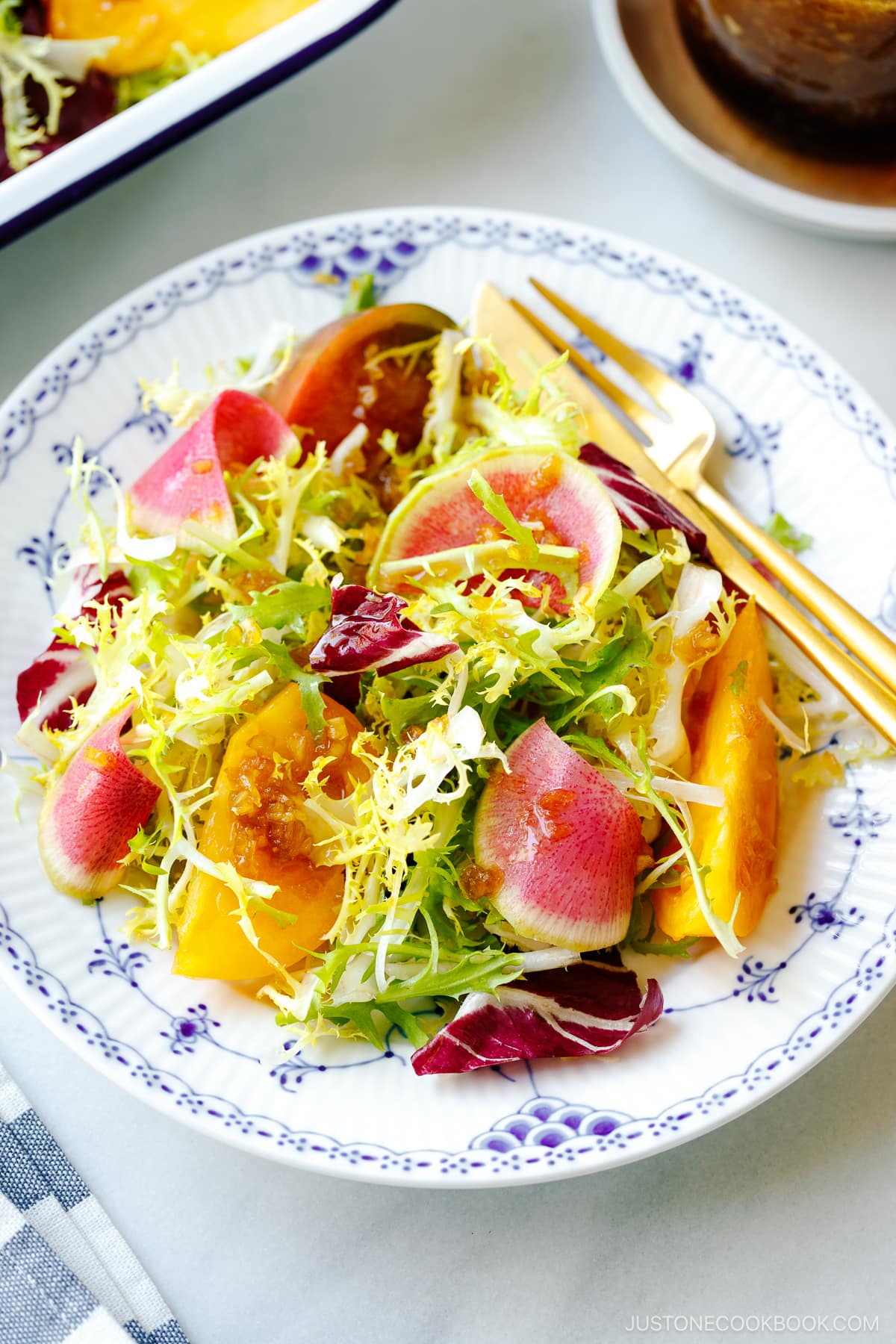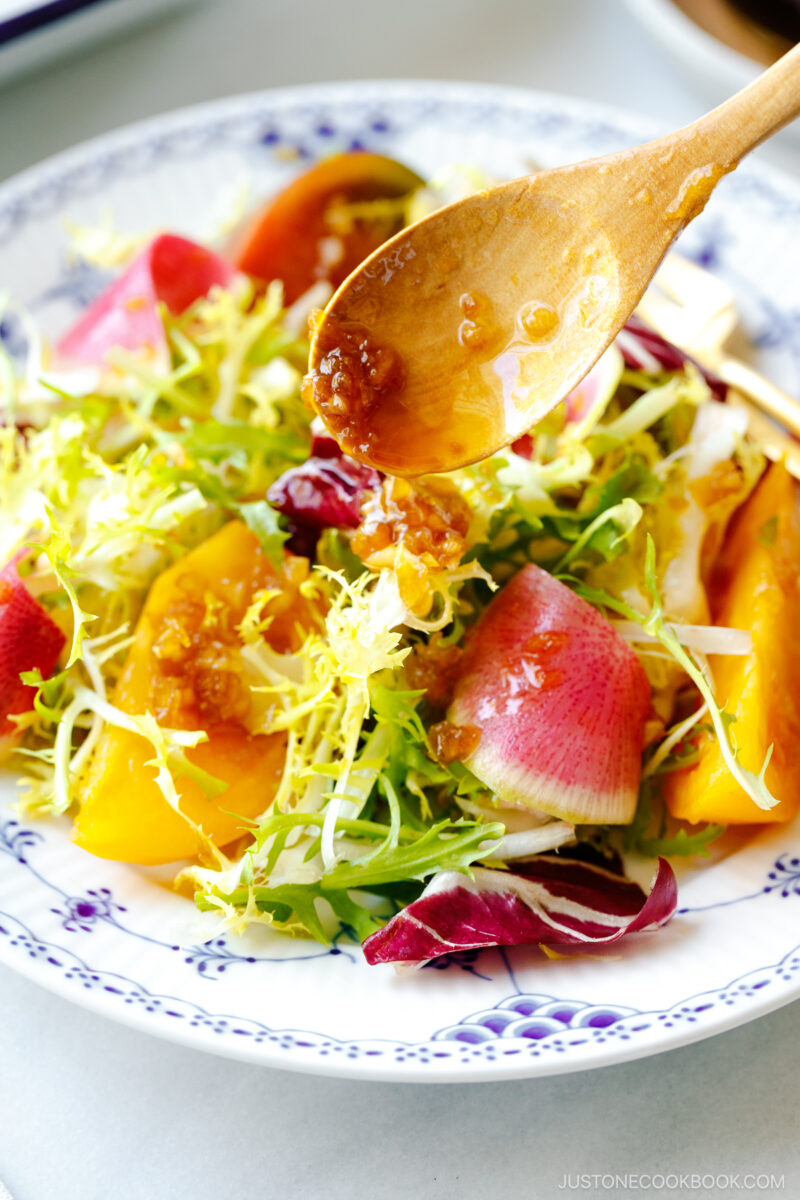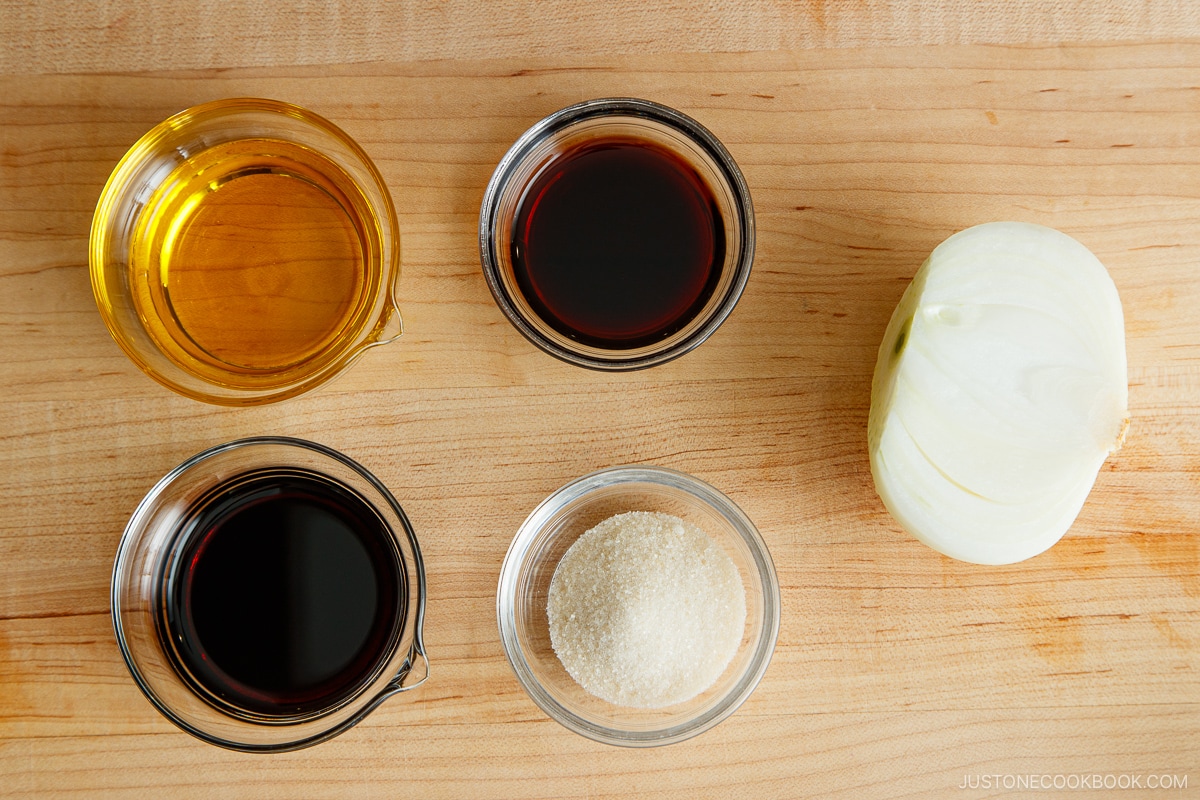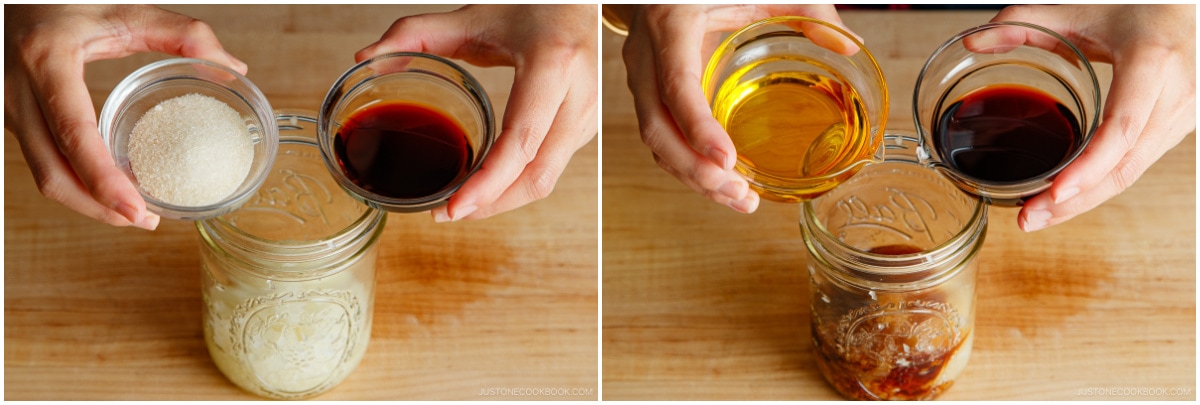This sophisticated yet simple Japanese Onion Dressing is my family‘s favorite! Savory, sweet, zingy, and packed with amazing flavors, it’s sure to win over fans. You‘ll love it on seafood, grilled meat, or greens like frisée and radicchio salad.

Mr. JOC (aka my husband) calls this dressing “Million-Dollar Dressing” because he thinks it’s the best homemade dressing I’ve ever made (I have a lot of homemade dressing recipes). And our kids wholeheartedly agree with him.
The truth is, none of them are particularly fond of onions. But, this dressing changed everything. It will make you want to eat a salad, as long as I pour this dressing over it.
Built on a base of finely grated and chopped sweet onion and soy sauce, you could hardly believe that it takes only 5 ingredients to make. The flavor is bright, savory, sweet, and layered with a deep flavor. You can’t go wrong with this Japanese Onion Dressing (玉ねぎドレッシング). I hope you enjoy it as much as my family does.
Table of Contents

Why You’ll Love This Recipe
- Brightly flavored, rich in umami, and textured – not your typical dressing.
- It’s super easy to make!
- It will take any salad to the next level, making it perfect for your holiday salad!
- More than just a salad dressing, you can even pour it over a simple baked fish and chicken.
3 Secrets to Making This Dressing
I truly think these little things make a difference in the final result.
- Use Japanese black vinegar (kurozu). Chinese black vinegar has a completely different flavor profile, so I don’t recommend substituting it. Kurozu brings incredible depth and flavor with a gentle punch. If you can’t get this ingredient, substitute it with rice vinegar.
- Prepare the onion two ways. First, grate half of the onion and keep the onion juice. I highly recommend using this ceramic grater to catch the juice. Then, finely mince the rest of the onion. Use the rocking motion with a knife to cut the onion into super fine mince.
- Keep the dressing overnight in the fridge so the flavors meld together. No shortcut!


How to Make Japanese Onion Dressing
The Ingredients You’ll Need
- Sweet onion
- Extra virgin olive oil (or you can use neutral oil)
- Japanese black vinegar (kurozu 黒酢) – This is the star ingredient, so I’ll talk more below. You can substitute it with rice vinegar
- Soy sauce
- Sugar
The Cooking Steps
- Grate half the onion and mince the rest.
- In a mason jar, combine the onions, oil, black vinegar, soy sauce, and sugar. Shake well.
- Keep in the fridge overnight so the ingredients will meld together.
- Enjoy it with salad, chicken, or fish!


Japanese Black Vinegar (Kurozu)

This Japanese black vinegar is called Rinkosan Kurozu Black Vinegar by Uchibori Brewery. Even though it’s made with just water and rice, kurozu (黒酢) or black vinegar brings a lovely depth and aroma to your dishes. It’s highly versatile and easy to use. Try it on your stir-fries like this Sweet and Sour Chicken, grilled or baked fish, or as a dipping sauce for gyoza.
You can purchase this black vinegar at Japanese grocery stores (I get mine at Nijiya Market) and some online stores sell it.
What’s in This Colorful Salad?
Here, I made a simple salad with frisée, radicchio, thinly sliced watermelon radish, and heirloom tomatoes.
How to Use This Japanese Onion Dressing
- Salad. This dressing goes well with simple shredded cabbage and leafy green salad.
- Meat and seafood. Drizzle this dressing on grilled chicken, roasted pork or pork shabu shabu, grilled steak, pan-fried salmon, and sautéed shrimp! We use it for so many kinds of food and it’s very delicious!

FAQs
How can I substitute if I can’t find this Japanese black vinegar?
You can use other brands of Japanese black vinegar, or simply use rice vinegar (do not use other types of vinegar, please!). Do not use Chinese black vinegar as it has a different taste. Substitution information is in the recipe card below.
Can I omit sugar? What is a good substitute for sugar?
Japanese black vinegar (or rice vinegar) is mild in taste compared to other types of vinegar, but it’s good to add a little bit of sweetness to counterbalance the vinegary taste and remove the sharpness for a rounded flavor.
You can use honey or other sugar substitute if you want to omit the granulated sugar.
Is this vegetarian or vegan?
Yes! The dressing is naturally vegan. Make a salad with vegan-friendly ingredients.
What’s the best Japanese onion dressing brand?
I tried both brands below and I like the one on the right in the picture below.

What to Serve with This Salad
- Salmon Potato Gratin
- Japanese Stewed Hamburger Steak (Nikomi Hambagu)
- Japanese Cream Stew (White Stew)
- Honey Soy Glazed Spatchcock Chicken
- Honey Garlic Pork Chops
- Japanese-style Pasta with Shrimp and Broccolini

Wish to learn more about Japanese cooking? Sign up for our free newsletter to receive cooking tips & recipe updates! And stay in touch with me on Facebook, Pinterest, YouTube, and Instagram.

Japanese Onion Dressing
Ingredients
- ½ sweet onion (3.5 oz, 100 g; divided for grating and mincing)
- ¼ cup extra virgin olive oil (or use neutral oil)
- 3 Tbsp Japanese black vinegar (kurozu) (this vinegar has a deep, mild flavor; rice vinegar is an acceptable substitute; do NOT use Chinese black vinegar as the flavor is completely different; you can purchase kurozu on Amazon)
- 1½ Tbsp soy sauce (increase to 2 Tbsp if you use rice vinegar)
- 4 tsp sugar (you can reduce this amount, but we use sugar to counterbalance the soy sauce and black vinegar)
For the Frisée and Radicchio Salad (optional)
- green salad (I used frisée and radicchio, thinly sliced watermelon radish, and heirloom tomatoes)
Instructions
- Gather all the ingredients.

- Cut ½ sweet onion in half with the root end intact. This helps hold the layers of the onion together while grating or mincing.

- Grate half the onion. I use my favorite ceramic grater to collect the onion juice. Onion juice is an important ingredient for the dressing, so make sure to collect all of it.

- Finely mince the remaining half of the onion (we call this Japanese cutting technique mijingiri). Lay the onion flat side down on the cutting board. With the knife edge toward the root end, make ⅛-inch horizontal slices to within ½ inch of the root end to keep it intact. Then, with the knife tip pointing toward the root end, make ⅛-inch vertical slices to within ½ inch of the root end. Finally, make perpendicular cuts down through the vertical slices you made.

- To mince the onion even finer, run your knife through the onion pieces using a rocking motion while holding down the tip of the knife.

- To a mason jar, add both the minced onion and the grated onion with all the onion juice.

- Add 4 tsp sugar, 1½ Tbsp soy sauce, ¼ cup extra virgin olive oil, and 3 Tbsp Japanese black vinegar (kurozu).

- Shake to combine and dissolve the sugar. Refrigerate overnight (8–12 hours) or longer to meld the flavors. The flavors of the dressing significantly improve after resting.

To Serve
- Make the optional green salad. Here, I simply toss together frisée and radicchio, thinly sliced watermelon radish, and heirloom tomatoes in a salad bowl. Drizzle the Japanese Onion Dressing on top, toss, and serve.

To Store
- You can keep the dressing in an airtight container and store it for 7 days in the refrigerator.








This is now my favourite salad dressing. I also sometimes add some finely minced pear and juice to add some extra sweetness and flavour.
Hello Robin! We are so happy to hear you enjoyed Nami’s recipe!
Thank you for trying her recipe and sharing your experience.
Happy Cooking!
I love your recipes but I’m on a low-sodium diet. Is the any substitute for soy sauce? Even low sodium soy sauce has too much.
Hi, Faith! Thank you for trying Nami’s recipe.
If the reduced-sodium soy sauce does not work, try using less soy sauce. You may also add extra black vinegar to balance the flavor if preferred.
We hope it works!
I’d recommending using less soy and use dashi stock. In Japan they use dashi and mirin. Also, olive oil might be too strong.
Hi, Matthew! Thank you for sharing this tip! Yes. Dashi stock is also an excellent alternative!
It is one of the most particular salads I have come across, I am very curious to try it even though the combination of these ingredients is not part of my culture.
Hi there! Thank you for reading Nami’s post!
We hope you enjoy the new combination. Happy Cooking!
I live with someone who doesn’t like the taste of vinegar (in any form). Could I replace vinegar with something else like lime, lemon, or tamarind? And how much would I use?
I realise that this is a very odd request but I have really struggled to come up with good salad dressings that don’t use vinegar (or mustard, which contains vinegar).
Thank you so much!
Hello, Chantal! Thank you so much for taking the time to read Nami’s post.
We can’t say how much would be the best balance because we haven’t tried it, but substituting lemon or lime for the vinegar should work. Starting with one tablespoon of lemon juice is a good place to start. If you prefer a stronger lemon flavor, add more and thoroughly mix it in.
If you give it a try, please let us know how it goes.🙂
I think you’re wonderful! you keep me close to my mom and heritage, she was born in Osaka! Arrigato !
Hello there! Thank you so much for your kind words about Nami.☺️
It meant so much to her.
We hope you will continue to enjoy cooking with us. If you have any questions about the recipe, please let us know!